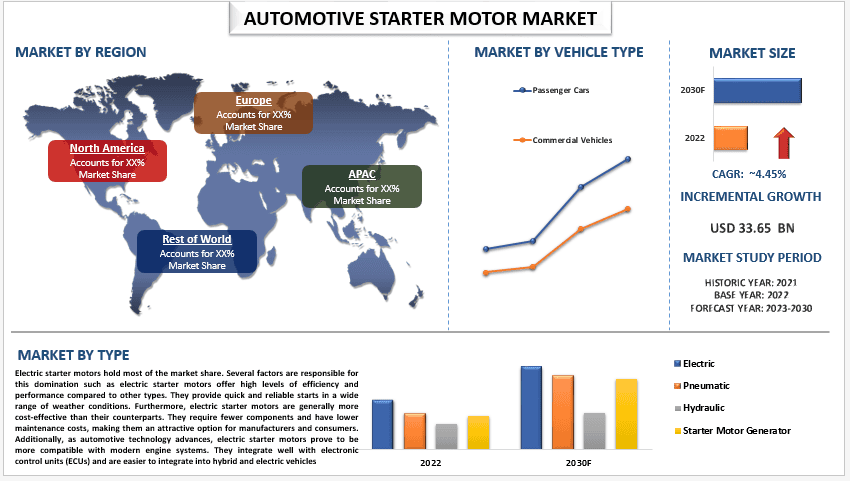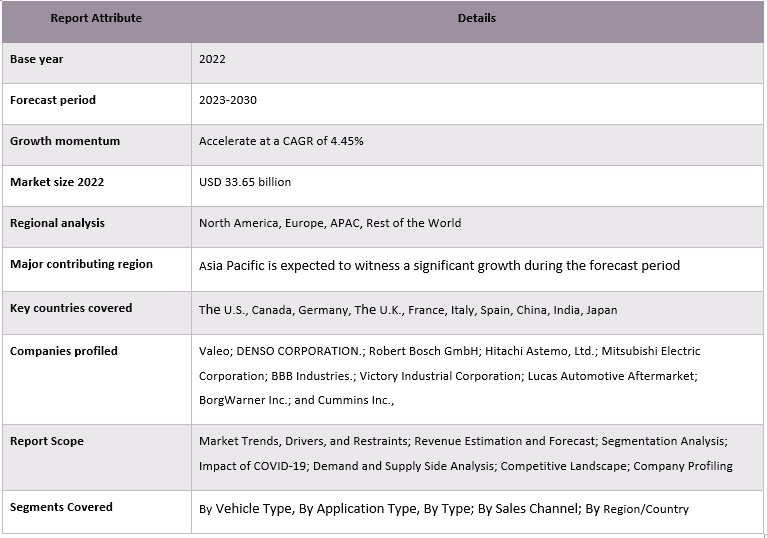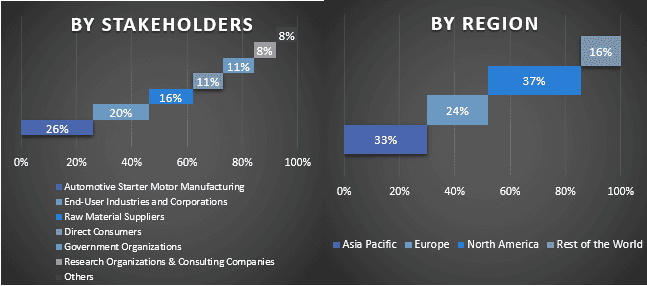- Home
- About Us
- Industry
- Services
- Reading
- Contact Us
Automotive Starter Motor Market: Current Analysis and Forecast (2023-2030)
Emphasis on Vehicle Type (Passenger Cars and Commercial Vehicles), Application (Internal Combustion Engines (ICE), and Hybrid/ Micro Hybrid Powertrains); Type (Electric, Pneumatic, Hydraulic, And Starter Motor Generators); Sales Channel (Original Equipment Manufacturer (OEM), and Aftermarket); and Region/Country

The Automotive Starter Motor Market was valued at 33.65 billion in the year 2022 and is expected to grow at a strong rate of around 4.45% during the forecast period (2023-2030), owing to the increasing vehicle production and growing demand for the commercial vehicles in the global markets. With global automotive production on the rise, the demand for starter motors has escalated significantly. As more vehicles hit the roads worldwide, the need for reliable ignition systems becomes paramount, contributing to the robust growth of the automotive starter motor market. Furthermore, emerging economies are witnessing robust economic growth, resulting in increased business activities and infrastructural developments. For instance, China has already surpassed the United States as the leading economy in terms of GDP in PPP (purchasing power parity) measurements and has the potential to become the largest economy based on market exchange rates before 2030. Additionally, India has the possibility of surpassing the United States by 2050 to secure the second position, while Indonesia could ascend to the fourth position, surpassing advanced economies such as Japan and Germany, by the same year. This economic expansion drives the demand for commercial vehicles, such as trucks and buses, for transportation, logistics, and construction purposes. As commercial vehicle sales soar, the demand for starter motors used in these vehicles also surges, contributing to the growth of the automotive starter motor market. Moreover, the expanding e-commerce and retail sectors have significantly driven the need for delivery vans and trucks. With the rise of online shopping, there is a growing requirement for reliable and efficient commercial vehicles for timely and convenient product deliveries. These vehicles rely on sturdy starter motors to ensure frequent ignition and reliable performance, leading to increased demand in the automotive starter motor market.
Some of the major players operating in the market include Valeo; DENSO CORPORATION.; Robert Bosch GmbH; Hitachi Astemo, Ltd.; Mitsubishi Electric Corporation; BBB Industries.; Victory Industrial Corporation; Lucas Automotive Aftermarket; BorgWarner Inc.; and Cummins Inc. Several M&As along with partnerships have been undertaken by these players to facilitate customers with hi-tech and innovative products/technologies.
Insights Presented in the Report
“Amongst vehicle types, the passenger vehicle automotive starter motor segment held the significant market share in 2022.”
Based on vehicle type, the market is bifurcated into passenger cars and commercial vehicles. The automotive industry has witnessed a significant dominance of passenger cars over commercial vehicles, and this trend continues to prevail in the global market. Furthermore, increasing urbanization, improved living standards and higher disposable incomes have contributed to a growing preference for personal mobility, leading to a higher demand for passenger cars. Additionally, infrastructure development, including well-maintained roads, highways, and parking facilities, has played a vital role in enabling the ownership and usage of passenger cars. Moreover, the emerging markets, especially in regions like Eastern Laos, Vietnam, and other Southeast Asian countries, have experienced rapid growth in their middle-class population. This demographic shift has resulted in a surge in demand for passenger vehicles, particularly IC Engine passenger cars. For instance, as per the findings of our market study, passenger cars constitute over 75% of total vehicle sales globally, based on data from leading automakers. In countries like India and China, which are experiencing significant economic growth, IC Engine passenger vehicles dominate the market, accounting for a substantial portion of overall vehicle sales. The International Energy Agency (IEA) reported that in 2020, IC Engine passenger cars accounted for approximately 46% of the total global vehicle fleet. Further, this rising production of IC Engine passenger cars necessitates a higher requirement for starter motors, as they are an essential component for initiating the engine, and hence are growing in demand.
“Amongst application types, the internal combustion engine starter motor held a significant share of the market in 2022.”
Based on application type, the market is divided into internal combustion engines (ICE), and hybrid/ micro hybrid powertrains. The automotive industry has been witnessing a steady rise in the adoption of hybrid and micro-hybrid powertrains in recent years. However, when it comes to the market share for automotive starter motors, Internal Combustion Engines (ICE) hold a significant majority. One of the significant factors contributing to the market dominance of ICE engines is the well-established infrastructure surrounding them. ICE engines have been the primary source of propulsion for automobiles for over a century, resulting in an extensive network of service centers, mechanics, and spare parts manufacturers. This infrastructure provides a sense of familiarity and reliability to consumers, making them more inclined toward ICE-powered vehicles. Furthermore, the existing supply chain and manufacturing ecosystem for ICE engines further contribute to their market dominance. Manufacturers have well-established processes, machinery, and suppliers in place, ensuring a seamless production cycle. This allows for economies of scale and cost efficiencies that hybrid powertrain manufacturers are still striving to achieve. The dominance of ICE engines in the market makes it challenging for hybrid powertrain manufacturers to compete on both price and production efficiency.
“Asia Pacific is anticipated to witness a significant growth during the forecast year (2023-2030).”
The Asia Pacific region has witnessed remarkable growth in the automotive industry, particularly in the automotive starter motors sector. With an increasing demand for technologically advanced vehicles coupled with a robust manufacturing infrastructure, this region has positioned itself as one of the fastest-growing automotive starter motor markets in the world. The Asia Pacific region is home to numerous automotive manufacturing hubs, including Japan, South Korea, China, and India. These countries have witnessed exponential growth in their domestic automotive industries, driving the demand for starter motors. For instance, according to the International Organization of Motor Vehicle Manufacturers, in 2021, China produced approximately 25 million vehicles, Japan produced 8 million vehicles, and India produced 4 million vehicles. Furthermore, rapid urbanization, rising disposable incomes, and the expanding middle class have fueled the demand for automobiles across Asia Pacific. The increasing vehicle ownership in countries like China and India has significantly contributed to the surge in the automotive starter motors market. For instance, the total number of passenger cars in India reached around 37 million in 2020, showcasing a substantial market potential. Moreover, in recent years, there has been a heightened emphasis on energy efficiency and reducing carbon emissions in the Asia Pacific region. Starter motors play a crucial role in this pursuit, as they directly impact a vehicle’s fuel consumption and emission levels. This push for energy-efficient automobiles has stimulated the demand for high-quality starter motors in the market.
Automotive Starter Motor Market Report Coverage

Reasons to buy this report:
- The study includes market sizing and forecasting analysis validated by authenticated key industry experts.
- The report presents a quick review of overall industry performance at one glance.
- The report covers an in-depth analysis of prominent industry peers with a primary focus on key business financials, product portfolios, expansion strategies, and recent developments.
- Detailed examination of drivers, restraints, key trends, and opportunities prevailing in the industry.
- The study comprehensively covers the market across different segments.
- Deep dive regional level analysis of the industry.
Customization Options:
The global automotive starter motor market can further be customized as per the requirement or any other market segment. Besides this, UMI understands that you may have your own business needs, hence feel free to contact us to get a report that completely suits your requirements.
Table of Content
Research Methodology for the Automotive Starter Motor Market Analysis (2023-2030)
Analyzing the historical market, estimating the current market, and forecasting the future market of the global automotive starter motor market were the three major steps undertaken to create and analyze the adoption of automotive starter motors in major regions globally. Exhaustive secondary research was conducted to collect the historical market numbers and estimate the current market size. Secondly, to validate these insights, numerous findings and assumptions were taken into consideration. Moreover, exhaustive primary interviews were also conducted, with industry experts across the value chain of the global automotive starter motor market. Post assumption and validation of market numbers through primary interviews, we employed a top-down/bottom-up approach to forecasting the complete market size. Thereafter, market breakdown and data triangulation methods were adopted to estimate and analyze the market size of segments and sub-segments of the industry pertains to. Detailed methodology is explained below:
Analysis of Historical Market Size
Step 1: In-Depth Study of Secondary Sources:
A detailed secondary study was conducted to obtain the historical market size of the automotive starter motor market through company internal sources such as annual reports & financial statements, performance presentations, press releases, etc., and external sources including journals, news & articles, government publications, competitor publications, sector reports, third-party database, and other credible publications.
Step 2: Market Segmentation:
After obtaining the historical market size of the automotive starter motor market, we conducted a detailed secondary analysis to gather historical market insights and share for different segments & sub-segments for major regions. Major segments are included in the report as vehicle type, application type, type, and sales channel. Further country-level analyses were conducted to evaluate the overall adoption of testing models in that region.
Step 3: Factor Analysis:
After acquiring the historical market size of different segments and sub-segments, we conducted a detailed factor analysis to estimate the current market size of the Automotive Starter Motor market. Further, we conducted factor analysis using dependent and independent variables such as the vehicle type, application type, type, and sales channel of the automotive starter motor market. A thorough analysis was conducted for demand and supply-side scenarios considering top partnerships, mergers and acquisitions, business expansion, and product launches in the automotive starter motor market sector across the globe.
Current Market Size Estimate & Forecast
Current Market Sizing: Based on actionable insights from the above 3 steps, we arrived at the current market size, key players in the global Automotive Starter Motor market, and market shares of the segments. All the required percentage shares split and market breakdowns were determined using the above-mentioned secondary approach and were verified through primary interviews.
Estimation & Forecasting: For market estimation and forecast, weights were assigned to different factors including drivers & trends, restraints, and opportunities available for the stakeholders. After analyzing these factors, relevant forecasting techniques i.e., the top-down/bottom-up approach were applied to arrive at the market forecast for 2030 for different segments and sub-segments across the major markets globally. The research methodology adopted to estimate the market size encompasses:
- The industry’s market size, in terms of revenue (USD) and the adoption rate of the automotive starter motor market across the major markets domestically
- All percentage shares, splits, and breakdowns of market segments and sub-segments
- Key players in the global automotive starter motor market in terms of products offered. Also, the growth strategies adopted by these players to compete in the fast-growing market.
Market Size and Share Validation
Primary Research: In-depth interviews were conducted with the Key Opinion Leaders (KOLs) including Top Level Executives (CXO/VPs, Sales Head, Marketing Head, Operational Head, Regional Head, Country Head, etc.) across major regions. Primary research findings were then summarized, and statistical analysis was performed to prove the stated hypothesis. Inputs from primary research were consolidated with secondary findings, hence turning information into actionable insights.
Split of Primary Participants in Different Regions

Market Engineering
The data triangulation technique was employed to complete the overall market estimation and to arrive at precise statistical numbers for each segment and sub-segment of the global automotive starter motor market. data was split into several segments & sub-segments after studying various parameters and trends in the areas of raw material and application in the global automotive starter motor market.
The main objective of the Global Automotive Starter Motor Market Study
The current & future market trends of the global automotive starter motor market were pinpointed in the study. Investors can gain strategic insights to base their discretion for investments on the qualitative and quantitative analysis performed in the study. Current and future market trends determined the overall attractiveness of the market at a regional level, providing a platform for the industrial participant to exploit the untapped market to benefit from a first-mover advantage. Other quantitative goals of the studies include:
- Analyze the current and forecast market size of the automotive starter motor market in terms of value (USD). Also, analyze the current and forecast market size of different segments and sub-segments.
- Segments in the study include areas of vehicle type, application type, type, and sales channel.
- Define and analyze the regulatory framework for the automotive starter motor
- Analyze the value chain involved with the presence of various intermediaries, along with analyzing customer and competitor behaviors of the industry
- Analyze the current and forecast market size of the automotive starter motor market for the major region
- Major countries of regions studied in the report include Asia Pacific, Europe, North America, and the Rest of the World
- Company profiles of the automotive starter motor market and the growth strategies adopted by the market players to sustain in the fast-growing market
- Deep dive regional level analysis of the industry
Frequently Asked Questions FAQs
Q1: What is the current market size and growth potential of the global Automotive Starter Motor market?
Q2: What are the driving factors for the growth of the global Automotive Starter Motor Market?
Q3: Which segment has the largest share of the global Automotive Starter Motor market by type?
Q4: What are the emerging technologies and trends in the global Automotive Starter Motor market?
Q5: Which region is the fastest growing in the global Automotive Starter Motor market?
Q6: Who are the key players in the global Automotive Starter Motor market?
Related Reports
Customers who bought this item also bought










